Vegan Yaki Udon stands as a testament to the versatility and creativity of plant-based cuisine. Originating from Japan, this dish has garnered global popularity for its tantalizing blend of savory flavors and satisfying textures. With its rich history and adaptable nature,
Vegan Yaki Udon has become a beloved staple in the repertoire of vegan cooks and food enthusiasts alike. Let’s embark on a culinary journey to discover the art of crafting this delectable stir-fried noodle dish.
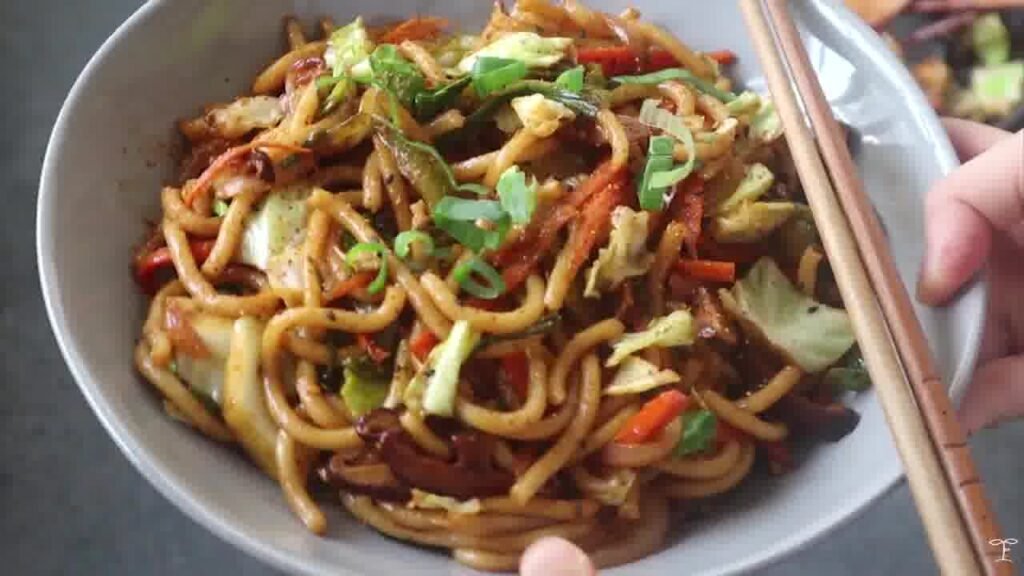
- More Recipes You’ll Love
- Vegan mayo recipe oat milk
What is Yaki Udon?
Yaki Udon is a popular Japanese stir-fried noodle dish made with thick udon noodles, assorted vegetables, and often meat or seafood, all cooked together in a savory sauce. The dish typically includes ingredients such as cabbage, carrots, bell peppers, and onions, creating a colorful and flavorful medley. Yaki Udon is known for its chewy texture, umami-rich taste, and quick preparation, making it a beloved choice for a satisfying meal or snack. It showcases the versatility of udon noodles and is enjoyed both at home and in restaurants across Japan and around the world.
Types of Udon Noodles
- Standard Udon Noodles: Thick, chewy wheat noodles that are the most commonly used type of udon. They have a neutral flavor and a satisfyingly dense texture.
- Inaniwa Udon: Hailing from Akita Prefecture, these udon noodles are thinner and flatter than standard udon, with a delicate texture that’s slightly chewy. They are often served in soups or cold with dipping sauce.
- Sanuki Udon: Originating from Kagawa Prefecture, these udon noodles are known for their firm, chewy texture. They are typically served in a simple broth or dipped in sauce.
- Kishimen: Flat udon noodles that originate from Nagoya, Kishimen noodles have a wide, ribbon-like shape and a slightly chewy texture. They are often served in a soy-based broth with various toppings.
- Tsuruton: Thin udon noodles that are often served in hot pots or soups. They have a delicate texture and absorb flavors well.
- Shirataki Udon: Made from konjac yam, these udon noodles are translucent and gelatinous with a chewy texture. They are low in calories and carbohydrates, making them a popular choice for those on low-carb or gluten-free diets.
The Essence of Vegan Yaki Udon:
At its essence, Vegan Yaki Udon embodies the essence of plant-based cooking—celebrating the abundance of flavors and textures that nature provides. The dish revolves around udon noodles, a thick and chewy wheat noodle that serves as the perfect canvas for absorbing savory sauces and marrying with an array of vegetables and proteins. What sets Vegan Yaki Udon apart is its ability to capture the essence of traditional Japanese cuisine while embracing the principles of veganism, making it accessible to a wide range of dietary preferences.
Bast Ingredients:
- Udon Noodles: Thick wheat noodles, preferably fresh or dried.
- Firm Tofu: Pressed and cubed tofu, for protein and texture.
- Assorted Vegetables:
- Bell Peppers: Sliced thinly for color and crunch.
- Carrots: Julienned or thinly sliced for sweetness and texture.
- Cabbage: Shredded for bulk and flavor.
- Spring Onions (Scallions): Sliced diagonally for a mild onion flavor.
- Any other vegetables of choice, such as mushrooms, broccoli, or snap peas.
- Sauce:
- Soy Sauce: For umami and saltiness.
- Mirin: Sweet rice wine for a touch of sweetness.
- Sesame Oil: Adds nuttiness and depth of flavor.
- Garlic: Minced or grated for aromatic flavor.
- Ginger: Minced or grated for a zesty kick.
- Garnishes (optional):
- Sesame Seeds: Toasted for nutty flavor and visual appeal.
- Nori Flakes: For a hint of umami and sea flavor.
- Sliced Green Onions: Adds freshness and color to the dish.
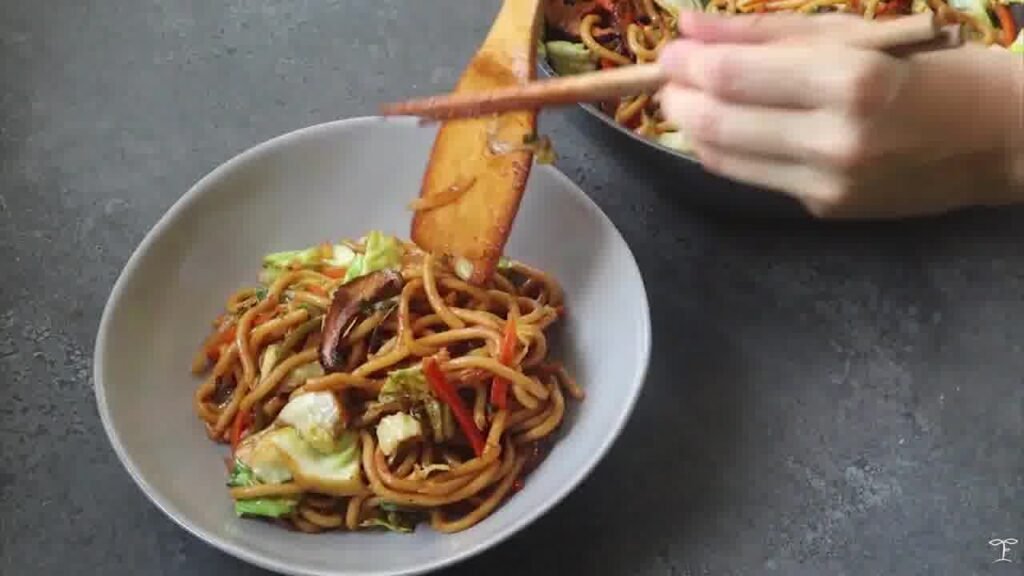
Preparation: How to make Vegan Yaki Udon:
Here’s a step-by-step guide on how to prepare Vegan Yaki Udon:
- Prepare the Ingredients:
- Cook the udon noodles according to package instructions until they are al dente. Once cooked, rinse them under cold water to prevent sticking.
- Press the tofu to remove excess moisture, then cut it into cubes.
- Slice the assorted vegetables (bell peppers, carrots, cabbage, etc.) into thin strips or bite-sized pieces.
- Mince or grate the garlic and ginger.
- Prepare the sauce by mixing soy sauce, mirin, sesame oil, minced garlic, and grated ginger in a bowl. Adjust the quantities to taste.
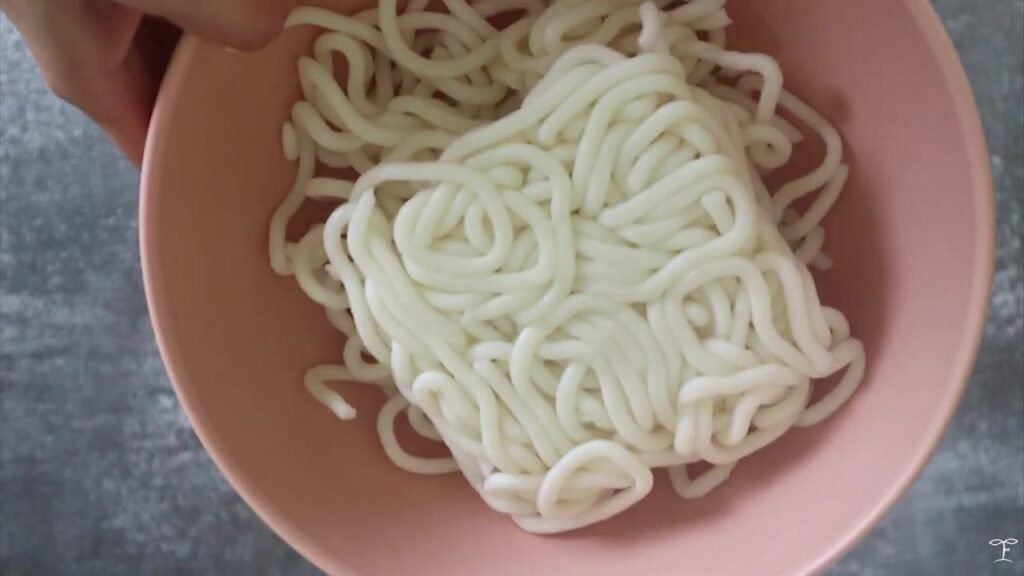
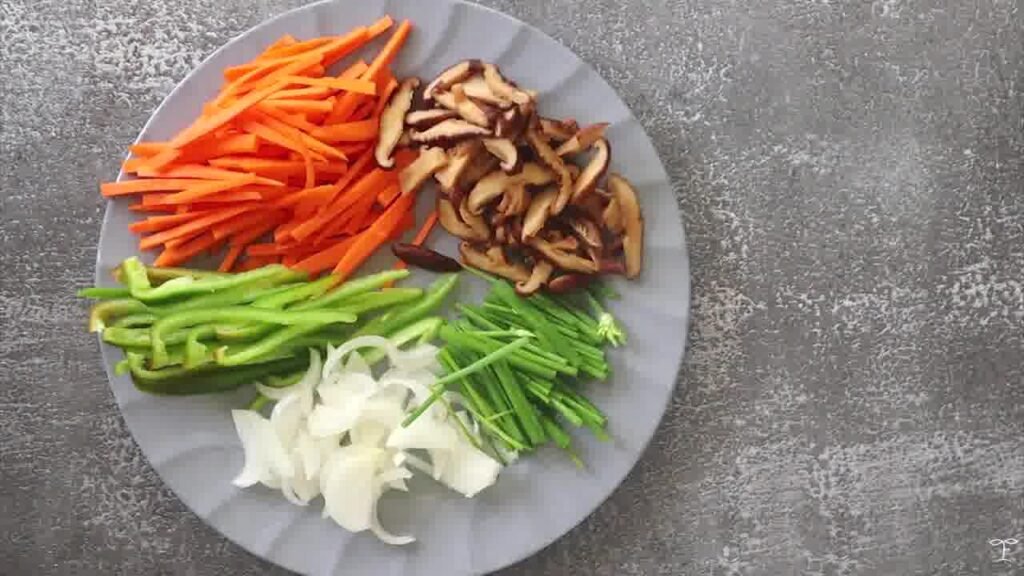
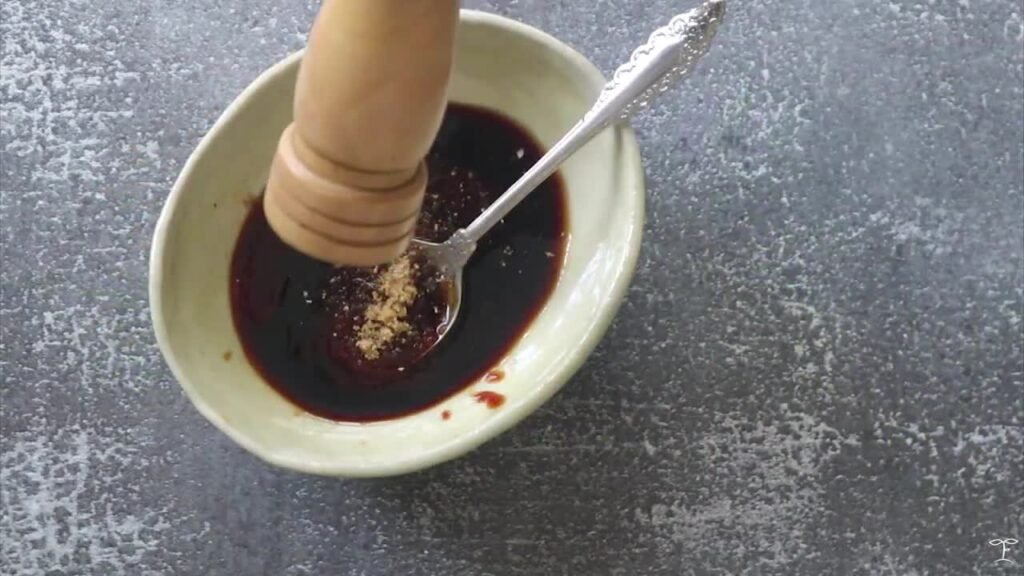
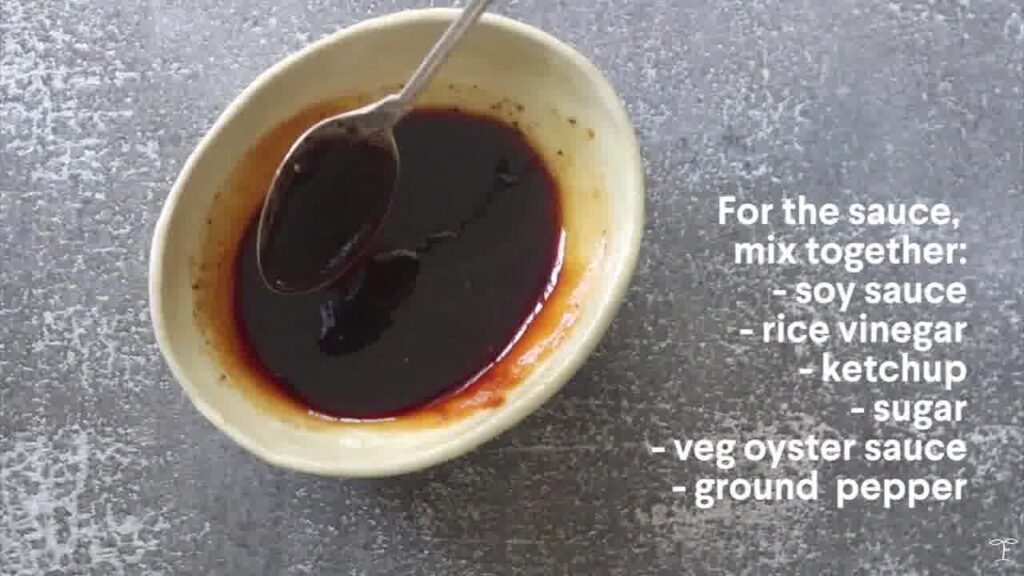
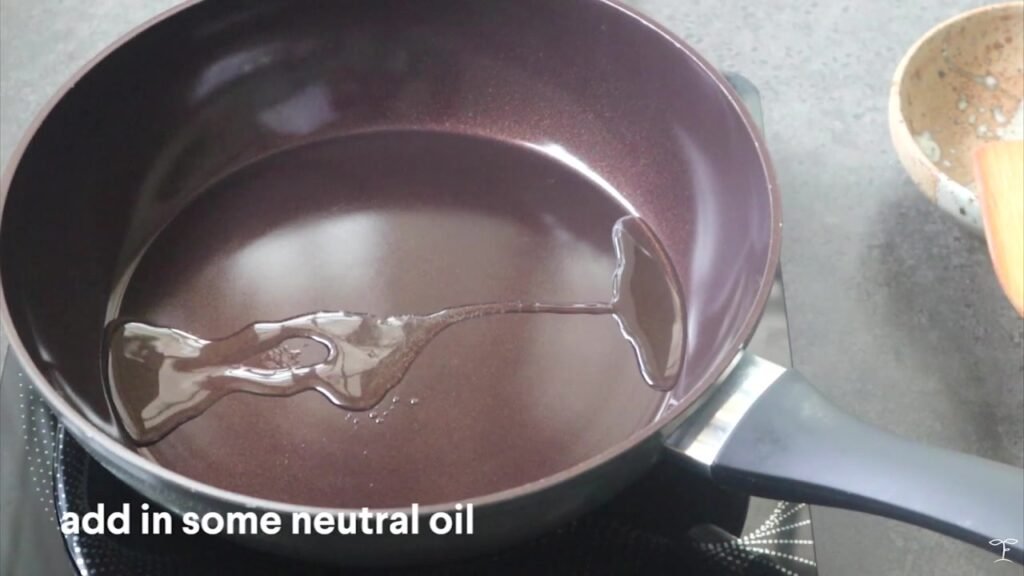
- Cook the Tofu:
- Heat a bit of oil in a large skillet or wok over medium-high heat.
- Add the cubed tofu to the skillet and cook until it turns golden brown and crispy on all sides, stirring occasionally. This should take about 5-7 minutes. Once done, remove the tofu from the skillet and set it aside.
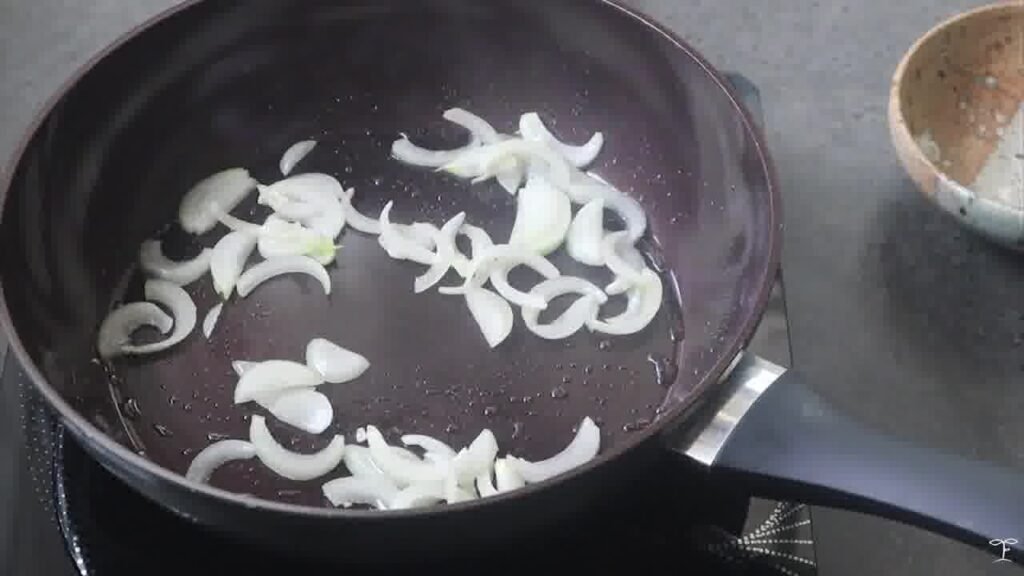
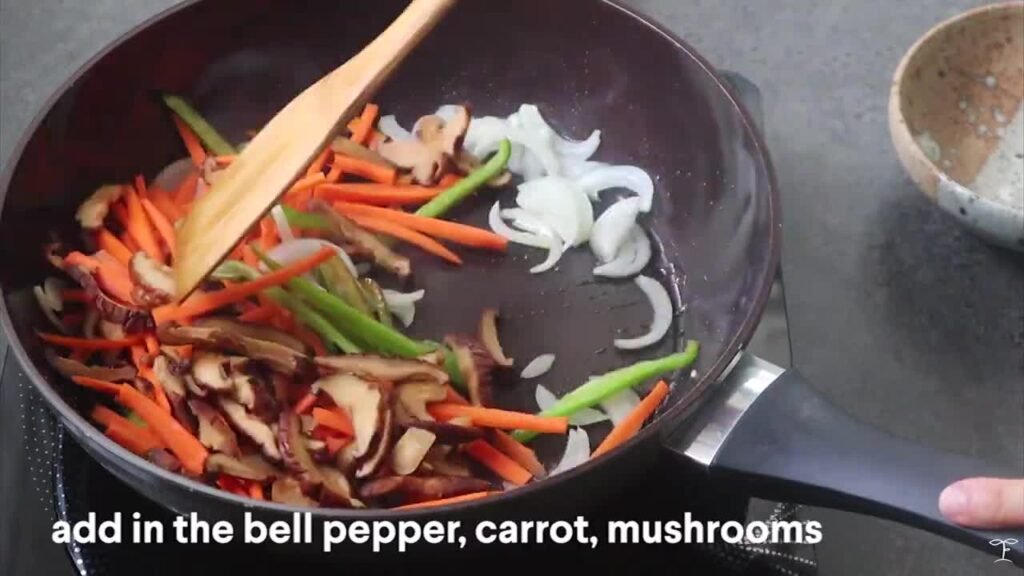
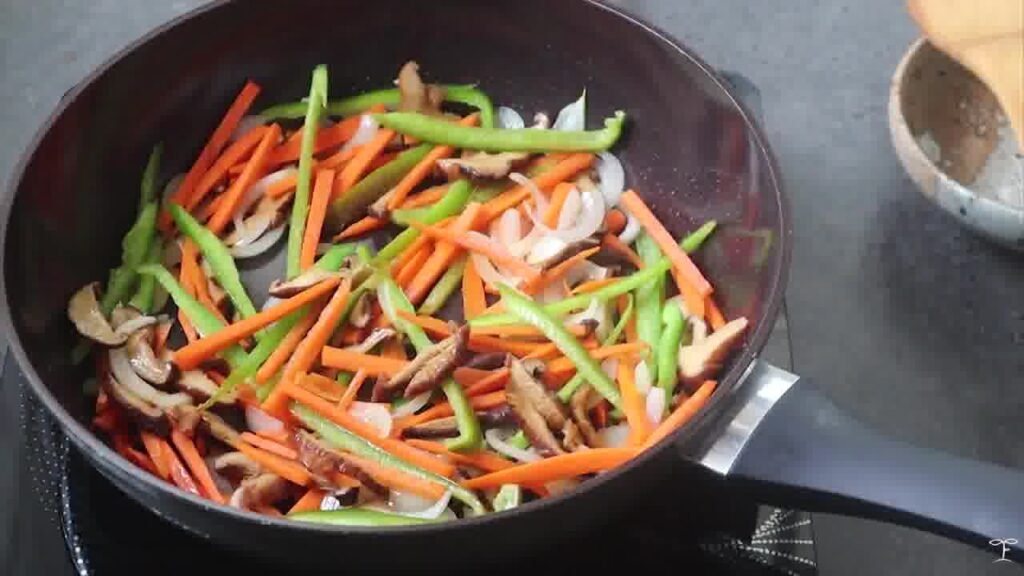
- Stir-Fry the Vegetables:
- In the same skillet, add a bit more oil if needed.
- Add the sliced vegetables to the skillet and stir-fry them until they are tender-crisp. This should take about 3-5 minutes, depending on the thickness of the vegetables.
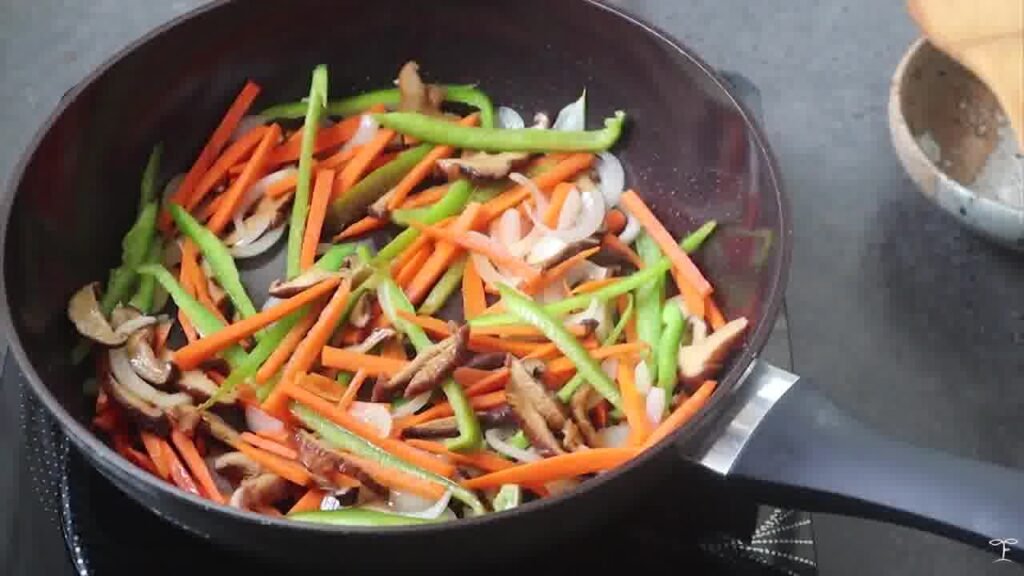
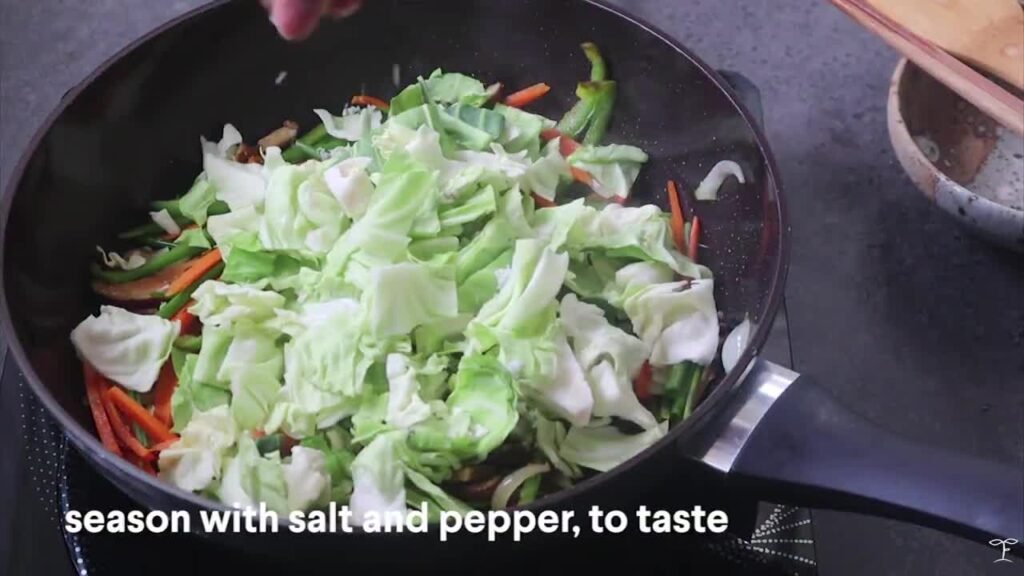
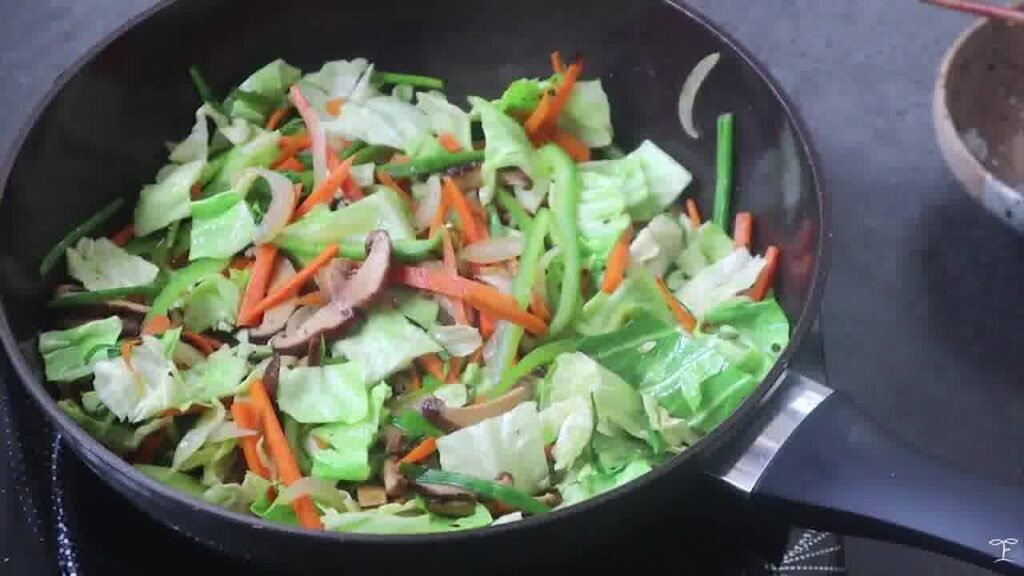
- Combine Everything:
- Return the cooked tofu to the skillet with the vegetables.
- Add the cooked udon noodles to the skillet as well.
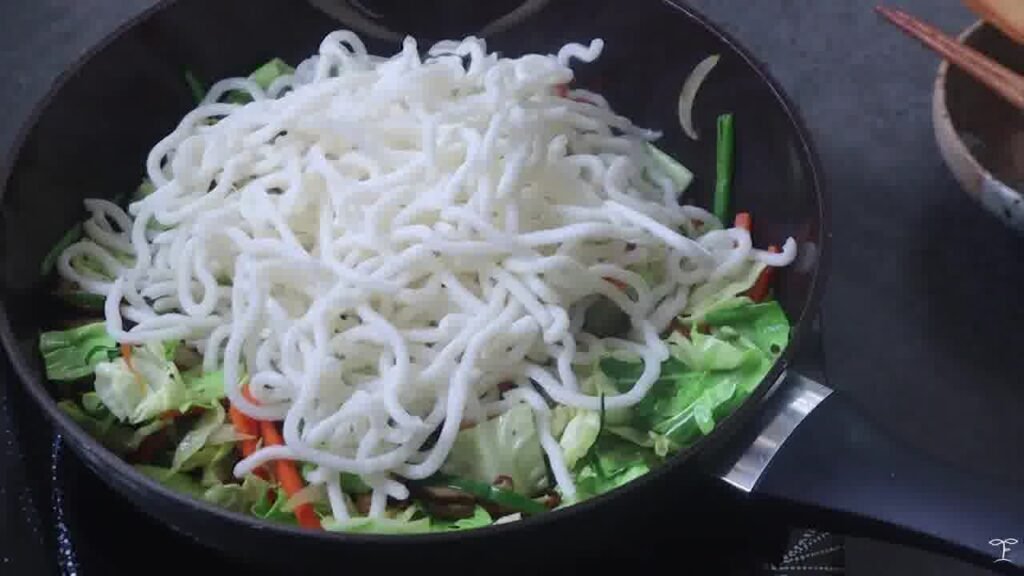
- Add the Sauce:
- Pour the prepared sauce over the tofu, vegetables, and noodles in the skillet.
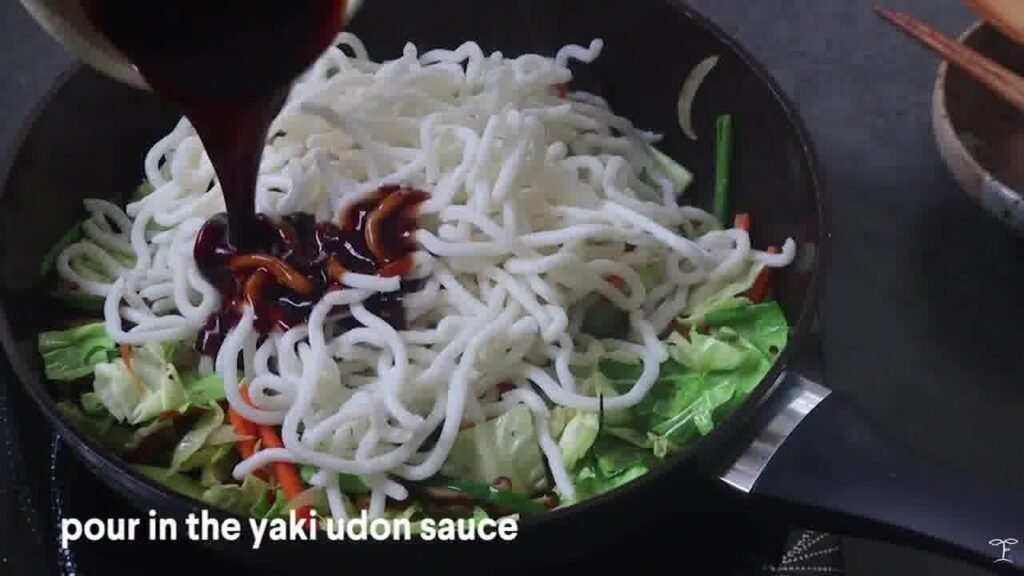
- Toss and Heat Through:
- Use tongs or a spatula to toss everything together, ensuring that the sauce coats all the ingredients evenly.
- Continue to stir-fry for another 2-3 minutes, or until everything is heated through and well combined.
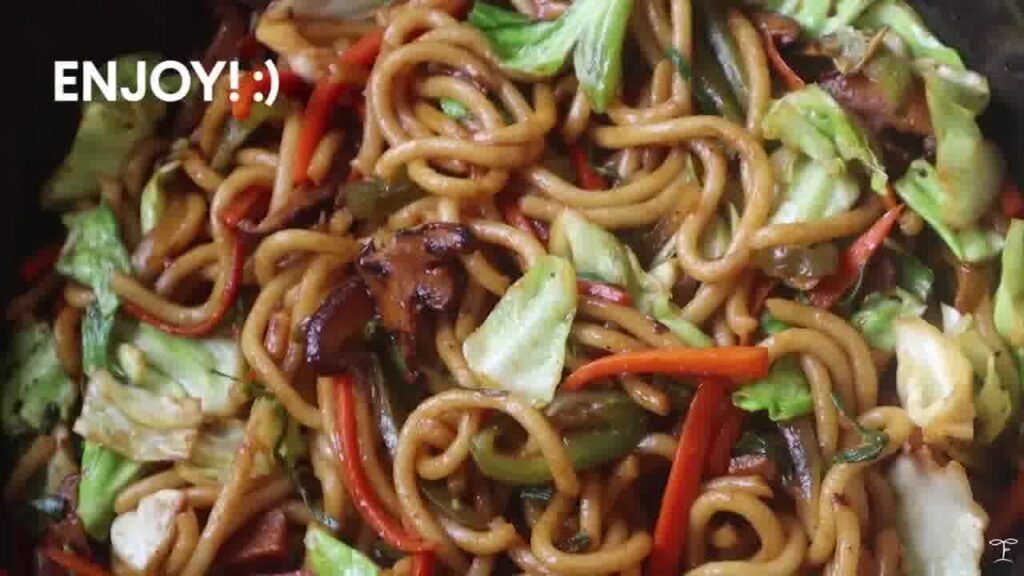
- Serve:
- Once the Vegan Yaki Udon is heated through, transfer it to serving plates or bowls.
- Garnish with optional toppings such as toasted sesame seeds, sliced green onions, or nori flakes, if desired.
- Serve hot and enjoy!
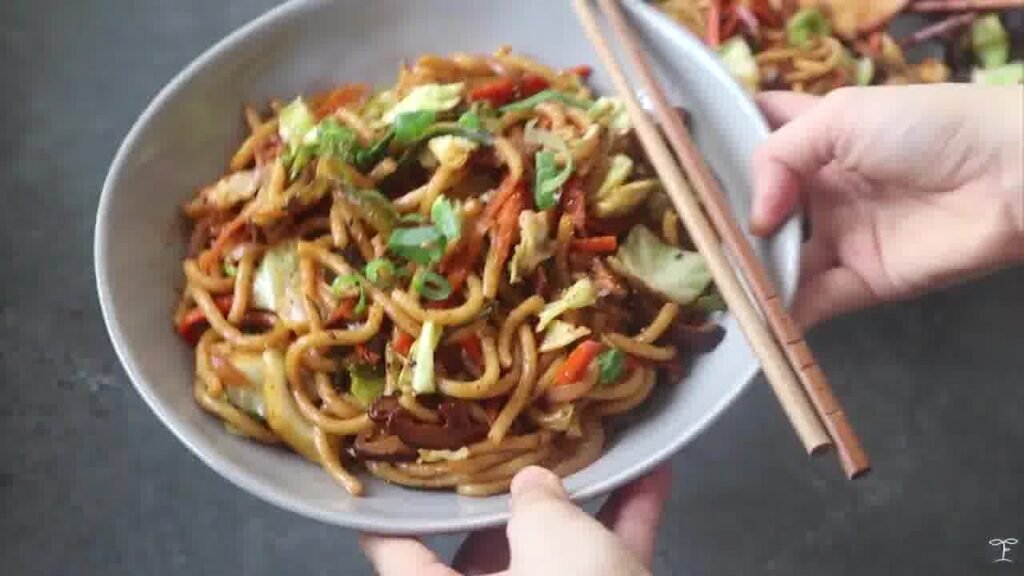
Tips for Success:
- Don’t overcook the vegetables. They should retain their vibrant colors and crisp texture to add freshness to the dish.
- Adjust the sauce to taste. Feel free to add more soy sauce for saltiness, mirin for sweetness, or sesame oil for richness.
- Customize the dish with your favorite vegetables or protein sources. Mushrooms, broccoli, snap peas, or seitan are all excellent additions.
- For extra flavor, consider adding a sprinkle of shichimi togarashi (Japanese seven-spice blend) or a drizzle of chili oil.
Substitutions:
- Tofu: Substitute tofu with tempeh, seitan, or your favorite plant-based protein.
- Udon Noodles: If udon noodles are unavailable, you can substitute them with soba noodles, rice noodles, or even spaghetti.
- Vegetables: Feel free to substitute or add different vegetables based on your preference or what you have on hand. Some options include mushrooms, broccoli, snap peas, bean sprouts, spinach, or kale.
- Soy Sauce: Substitute soy sauce with tamari for a gluten-free option, or use coconut aminos for a soy-free alternative.
- Mirin: If you don’t have mirin, you can substitute it with a mixture of rice vinegar and a touch of sugar, or use dry sherry or sweet white wine.
- Sesame Oil: Substitute sesame oil with peanut oil, sunflower oil, or any other neutral-flavored oil.
Additions:
- Garlic Chili Sauce: Add a spoonful of garlic chili sauce or sriracha for a spicy kick.
- Peanut Butter: Mix some peanut butter into the sauce for a creamy and nutty flavor.
- Fresh Herbs: Garnish with chopped cilantro, Thai basil, or mint for a burst of freshness.
- Crushed Peanuts: Sprinkle crushed peanuts on top for added texture and flavor.
- Baby Corn: Add baby corn for a sweet and crunchy addition to the dish.
- Pineapple: For a touch of sweetness, add chunks of pineapple to the stir-fry.
How to store Vegan Yaki Udon (Stir-Fried Noodles)
- Cooling Down: Allow the Vegan Yaki Udon to cool down to room temperature before storing it. This helps prevent condensation inside the container, which can make the noodles soggy.
- Refrigeration: Transfer the cooled Vegan Yaki Udon to an airtight container or a resealable plastic bag. Ensure the container is clean and dry before adding the noodles.
- Labeling and Dating: If you’re storing the Vegan Yaki Udon for more than a day, label the container with the date of preparation. This helps you keep track of its freshness.
- Refrigerator Storage: Place the sealed container in the refrigerator. Vegan Yaki Udon can typically be stored in the refrigerator for up to 3-4 days.
- Freezing (Optional): If you want to store Vegan Yaki Udon for longer periods, consider freezing it. Portion the noodles into individual servings before freezing to make it easier to defrost only what you need.
- Defrosting: When ready to eat, transfer the frozen Vegan Yaki Udon to the refrigerator and allow it to defrost overnight. Alternatively, you can reheat it directly from frozen by placing it in a microwave-safe dish and microwaving it on a low setting, stirring occasionally until heated through.
- Reheating: Reheat the Vegan Yaki Udon in a skillet or microwave until heated through, adding a splash of water or vegetable broth if needed to prevent drying out.
- Check for Freshness: Before consuming, check the noodles for any signs of spoilage, such as an off smell or appearance. If the noodles appear or smell off, it’s best to discard them to avoid foodborne illness.
Frequently Ask Question:-
Can vegans eat udon noodles?
Yes, vegans can eat udon noodles. Udon noodles are typically made from wheat flour, water, and salt, making them entirely plant-based. They are a popular staple in vegan cuisine and can be enjoyed in various dishes such as soups, stir-fries, and cold salads.
What is yaki udon made of?
Yaki Udon is made of thick wheat udon noodles stir-fried with assorted vegetables, meat or seafood, and savory sauces. Common ingredients include bell peppers, cabbage, carrots, and soy sauce. It’s a versatile dish with variations to suit different tastes, offering a satisfying and flavorful meal.
What is the difference between yaki udon and ramen?
Yaki Udon and Ramen are both popular Japanese noodle dishes, but they differ in their noodles and preparation. Yaki Udon uses thick, chewy wheat noodles stir-fried with vegetables and sauces, while Ramen features thinner wheat noodles served in a flavorful broth with various toppings like meat, vegetables, and eggs.
Are yaki udon noodles healthy?
Yaki Udon noodles can be part of a healthy diet when enjoyed in moderation. Made primarily from wheat flour and water, they provide carbohydrates for energy. However, the dish’s overall healthiness depends on ingredients and cooking methods, as sauces and added fats can affect nutritional value.
Ingredients
- 250 grams Udon Noodles (fresh or dried)
- 200 grams Firm Tofu, pressed and cubed
- 1 Red Bell Pepper, thinly sliced
- 1 Carrot julienned or thinly sliced
- 2 cups Shredded Cabbage
- 2 Spring Onions (Scallions), sliced diagonally
- 2 cloves Garlic, minced
- 1 teaspoon Ginger, grated
- 2 tablespoons Soy Sauce
- 1 tablespoon Mirin (Japanese sweet rice wine)
- 1 tablespoon Sesame Oil
Optional Garnishes:
- esame Seeds, for garnish
- Nori Flakes, for garnish
- Sliced Green Onions, for garnish
Instructions
Prepare the Ingredients:
- Cook the udon noodles according to package instructions until they are al dente. Once cooked, rinse them under cold water to prevent sticking.
- Press the tofu to remove excess moisture, then cut it into cubes.
- Slice the assorted vegetables (bell peppers, carrots, cabbage, etc.) into thin strips or bite-sized pieces.
- Mince or grate the garlic and ginger.
- Prepare the sauce by mixing soy sauce, mirin, sesame oil, minced garlic, and grated ginger in a bowl. Adjust the quantities to taste.
Cook the Tofu:
- Heat a bit of oil in a large skillet or wok over medium-high heat.
- Add the cubed tofu to the skillet and cook until it turns golden brown and crispy on all sides, stirring occasionally. This should take about 5-7 minutes. Once done, remove the tofu from the skillet and set it aside.
Stir-Fry the Vegetables:
- In the same skillet, add a bit more oil if needed.
- Add the sliced vegetables to the skillet and stir-fry them until they are tender-crisp. This should take about 3-5 minutes, depending on the thickness of the vegetables.
Combine Everything:
- Return the cooked tofu to the skillet with the vegetables.
- Add the cooked udon noodles to the skillet as well.
Add the Sauce:
- Pour the prepared sauce over the tofu, vegetables, and noodles in the skillet.
Toss and Heat Through:
- Use tongs or a spatula to toss everything together, ensuring that the sauce coats all the ingredients evenly.
- Continue to stir-fry for another 2-3 minutes, or until everything is heated through and well combined.
Serve:
- Once the Vegan Yaki Udon is heated through, transfer it to serving plates or bowls.
- Garnish with optional toppings such as toasted sesame seeds, sliced green onions, or nori flakes, if desired.
- Serve hot and enjoy!
Video
Conclusion: Vegan Yaki Udon is a celebration of flavor, texture, and ingenuity—a dish that demonstrates the endless possibilities of plant-based cooking. With its savory sauce, chewy noodles, and colorful array of vegetables, it satisfies cravings and nourishes the body with each delicious bite. Whether enjoyed as a quick weeknight meal or served as a centerpiece at gatherings, Vegan Yaki Udon invites all to savor the joys of vegan cuisine and embrace the beauty of plant-based living.






